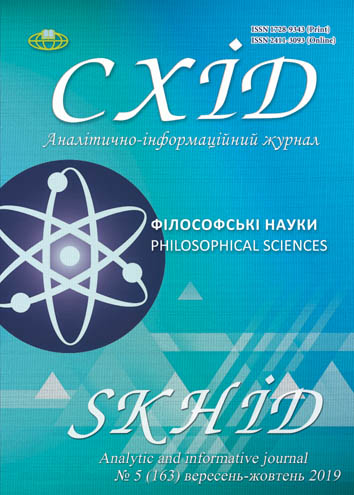Russia's migration weapon against Ukraine: a socio-cultural dimension
DOI:
https://doi.org/10.21847/1728-9343.2019.5(163).181855Keywords:
hybrid war, migration, migration weapons, temporarily occupied territories of Donetsk and Luhansk regionsAbstract
The article is devoted to non-military and non-lethal means and instruments of the war of the Russian Federation against Ukraine, which, in combination with conventional weapons, kills both combatants and civilians, destroys housing, infrastructure, generates, another powerful weapon against the object of aggression, which is migration that has a large and long-lasting "zone" of defeat. Defining the characteristics that turn migration into a tool of hybrid warfare is an acute problem in the face of our country's hybrid aggression of the Russian Federation. Finding adequate measures to eliminate the devastating effects of migration processes both inside and outside Ukraine nowadays, furthermore, perhaps, much more important for the future, is one of the national policy priorities, the key to national security. The migration consequences of the Russian-Ukrainian war are analyzed, which should be regarded as pre-planned means of conducting a hybrid war. The article focuses on the hidden and artificially disguised sociocultural aspects of the defeat of migrant weapons, such as artificial prohibition, restrictions, targeted movement of population from temporarily occupied areas of Donetsk and Luhansk regions. It is concluded that the concealment of socio-cultural defeat creates the effect of a slow-motion explosion, which can detonate at any moment and be used as a time mechanism in the hands of the aggressor in political, information, educational, mental spaces: loosening of social unity, creating agents of influence of "Russian peace", the introduction of intolerance and socio-regional xenophobia, the transformation of temporarily occupied territories into an educational and intellectual ghetto. The possibility and necessity of finding countermeasures to migratory weapons located in the same plane in which the areas of damage are created should be noted, to act adequately to eliminate the consequences and prevent recurrence.Downloads
References
Balakirieva, O. M. (ed.) (2016). Vymusheni pereselentsi ta pryimaiuchi hromady: uroky dlia efektyvnoi suspilnoi adaptatsii y intehratsii. Kyiv: NAN Ukrainy, DU «In-t ekon. ta prohnozuv. NAN Ukrainy». 140 p. (In Ukrainian)
Chuprii, L. (2018). Adaptatsiia vymushenykh pereselentsiv zi Skhodu Ukrainy: stan i problemy. In: Rosiiska ahresiia proty Ukrainy: pravda i vyhadky, prychyny i naslidky. Kyiv: MP Lesia, pp. 370-385. (In Ukrainian)
Greenhill, Kelly M. (2016). Migration as a Weapon in Theory and in Practice. Military Review, 96. no. 6. (Nov-Dec): 23-36.
Greenhill, Kelly M. (2010). Weapons of Mass Migration: Forced Displacement, Coercion, and Foreign Policy. Ithaca, NY: Cornell University Press, 360 р.
Gridina, I. M. and Hedo, A. V. (2018). Studentska akademichna mobilnist v konteksti derzhavnykh interesiv ta natsionalnoi bezpeky. Internatsionalizatsiia vyshchoi osvity Ukrainy v umovakh polikulturnoho svitovoho prostoru: stan, problemy, perspektyvy: mater. II mizhnar. nauk.-prakt. konf., m. Mariupol, 18-19 kvitnia 2018 r. Mariupol: MDU, pp. 156-158. (In Ukrainian)
Gridina, I. M. (2016). Osvitianskyi front viiny na Skhodi Ukrainy. Visnyk Mariupolskoho derzhavnoho universytetu. Seriia: istoriia, politolohiia. Issue 16: 199-208. Retrieved from http://www.irbis-nbuv.gov.ua/cgi-bin/irbis_nbuv/cgiirbis_64.exe?I21DBN=LINK&P21DBN=UJRN&Z21ID=&S21REF=10&S21CNR=20&S21STN=1&S21FMT=ASP_meta&C21COM=S&2_S21P03=FILA=&2_S21STR=Vmdu_ip_2016_16_27 (Accessed: 18.09.2019) (In Ukrainian)
Horbulin, V. P. (ed.) (2017). Svitova hibrydna viina: ukrainskyi front. Kyiv: Natsionalnyi instytut stratehichnykh doslidzhen. 496 p. (In Ukrainian)
Kolinko, M. (2017). Transhresiia povsiakdennosti: dosvid pereselennia v umovakh hibrydnoi viiny na Donbasi. In: Hibrydna viina: in verbo et in praxi. Vinnytsia: Nilan-LTD: 363-379. (In Ukrainian)
Kolinko, M. (2019). Nomadism as a way of being of the immigrants and internally displaced persons. EUREKA: Social and Humanities, 2: 56-62. DOI: 10.21303/2504-5571.2019.00868
Kolinko, M. V. (2019). Mizhkulturna komunikatsiya: topolohichnyy vymir. Vinnytsya: TOV «TVORY», 344 р. (In Ukrainian)
Kraliuk, P. (2016, 05). Ukraina i Rosiia. Bizhentsi u hibrydnykh viinakh Kremlia. Website VOA, Inc. Retrieved from https://ukrainian.voanews.com/a/ukraine-and-russia/3270226.html (Accessed: 20.09.2019). (In Ukrainian)
Malynovska, O. A. (2018). Mihratsiina polityka: hlobalnyi kontekst ta ukrainski realii. Kyiv: Natsionalnyi instytut stratehichnykh doslidzhen. 472 p. (In Ukrainian)
Malynovska, O. A. and Kolomoiets, O. O. (2017). Mihratsiinyi aspekt hibrydnoi viiny Rosii proty Ukrainy. Demohrafiia ta sotsialna ekonomika, 2 (30): 78-88. DOI: https://doi.org/10.15407/dse2017.02.078 (In Ukrainian)
Malynovska, O. A. Vnutrishnia mihratsiia ta tymchasovo peremishchenni v Ukraini v umovakh politychnykh ta sotsialno-ekonomichnykh zahroz: Analitical Report. Retrieved from http://old2.niss.gov.ua/content/articles/files/vnutrishnya_migratsia-45aa1.pdf (Accessed: 20.09.2019). (In Ukrainian)
Mansoor, Peter R. and Murray, W. (2012). Hybrid War in History. Hybrid Warfare: Fighting Complex Opponents from the Ancient World to the Present. Cambridge: Cambridge University Press: 1-18.
Serebryannikov, V. V. (1998). Sotsiologiya voyny. Moscow: Os-89, 320 p. (In Russian)
Vedeneev, D. (2019). Vid Makiavelli do viin robotiv: hramatyka «hibrydnoi» viiny. Oboronno-promyslovyi kurier. 02.19. Retrieved from http://opk.com.ua/vid-makiavelli-do-viin-robotiv-hramat/ (In Ukrainian) (Accessed: 20.09.2019)
Veselska, L. A. (2017). Masova vymushena mihratsiia yak instrument vedennia hibrydnoi viiny. Menedzher, 3 (76): 108-117. Retrieved from http://dsum.edu.ua/wp-content/uploads/2015/11/%E2%84%96-3-76-2017.pdf (Accessed 17.08.2019) (In Ukrainian)
Downloads
Published
How to Cite
Issue
Section
License
Copyright (c) 2019 Iryna Gridina, Maryna Kasyanova

This work is licensed under a Creative Commons Attribution-NonCommercial-NoDerivatives 4.0 International License.
1. Authors bear responsibility for the accuracy of facts, quotations, numbers and names used.
2. Manuscripts are not sent back.
3. The publisher does not always agree with the authors' opinion.
4. The authors reserve the right to authorship of the work and pass the first publication right of this work to the journal under the terms of a Creative Commons Attribution-NonCommercial-NoDerivatives 4.0 International License. This license allows others to distribute (copy) the published work for non-commercial purposes, provided there is mandatory attribution to its authors and a link to the first publication in our journal.
5. The authors have the right to conclude separate supplement agreements that relate to non-exclusive work distribution in the form in which it has been published by the journal (for example, to upload the work to the online storage of the journal or publish it as part of a monograph), provided that the reference to the first publication of the work in this journal is included.

